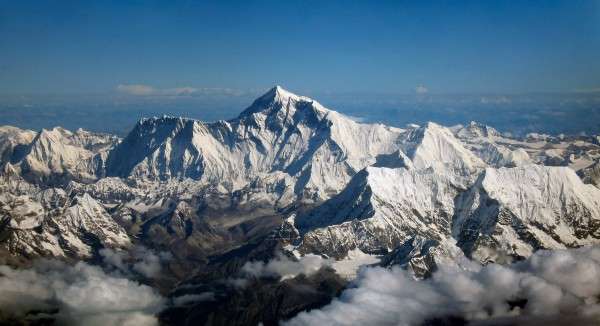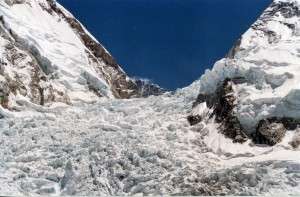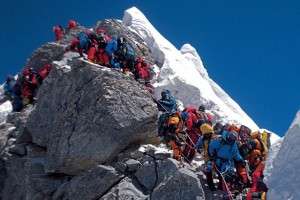Mt. Everest not safe from climate change

The last two years have witnessed the two deadliest disasters in Everest climbing history, and many say climate change is to blame.
Earlier this year, two earthquakes hit Nepal within weeks of each other, first on April 25 and another on May 12. The first earthquake triggered several avalanches on Mount Everest, resulting in at least 22 deaths, making it the most deadly day in the mountain's history.
A year before on April 18, an avalanche was triggered by a falling serac – a block or column of glacial ice – on Everest's notoriously dangerous Khumbu Icefall. The most deadly event in Everest's history up until then, the avalanche killed 16 people, all of whom were Nepalese guides.
For several years there had been concerns over a 980-foot wide serac above the Khumbu Icefall. Himalayan Experience, the mountain's most profitable guiding company, cancelled summit expeditions in 2012 due to concerns over this cliff of ice. According to author and mountaineer Jon Krakauer, the 2014 avalanche was caused by a chunk of ice "the size of a Beverly Hills mansion" that broke off from the serac.
The Khumbu Icefall can move up to six feet a day, making this half-mile stretch one of the most treacherous of the climb. One veteran guide recently told the Associated Press, "If it wasn't the tallest mountain in the world, you would never put yourself on a glacier this active."
The number of climbers on Everest has skyrocketed in recent years, and improvements in weather forecasting have made it all the more dangerous when bottlenecks of climbers attempting to summit in favorable conditions occur. A widely circulated photo by German mountaineer Ralf Dujmovits shows hundreds of people following the same rope line up the mountain in 2012. A year later, mountaineers reported waiting two and a half hours to summit due to crowding and inexperienced climbers. One day in 2012 saw 234 climbers summit, while in 1983, the highest daily number was 8. As recently as 2009 it was barely over 100.
On the whole, climbing Everest has become much more safe, but anecdotal evidence suggests that the mountains are changing, and rapidly, becoming less packed with snow and ice and experiencing more volatile conditions.

Photos from the 1950s show far more snow and ice on the peaks, and the last living Sherpa from the first successful expedition in 1953 has said that the now rocky dirt pathway to Base Camp used to be a trail of pristine ice.
According to another Sherpa named Apa, who has climbed Everest a record 21 times, "In 1989 when I first climbed Everest there was a lot of snow and ice but now most of it has become rock. That, as a result, is causing more rockfalls which is a danger to the climbers." He has also said that climbing has become much more dangerous due to the mix of rocks and ice, as the crampons that climbers must wear are incredibly slippery on bare rock.
Then, there is the fact that climbing Everest is far less dangerous for wealthy foreigners than for Sherpas, who are not as well equipped, carry far more gear and have to spend substantially more time in dangerous areas like the Khumbu Icefall.
Due to the changing and more dangerous conditions, Apa says his days of climbing the mountain may be over. However, with the surging numbers of wealthy foreigners looking to climb Mount Everest, and the large revenues the Nepalese government generates from climbing permits (currently $11,000 per permit, down from $25,000 in previous years), it seems unlikely that people will stop climbing anytime soon. After all, between 1921 and 1996, one person died for every four who successfully summited. This figure is now one for every sixty.
A number of recent studies have corroborated the rapid rate of change that has been taking place on Mount Everest.
A 2014 study from the International Centre for Integrated Mountain Development (ICIMOD) found that increases in global temperatures have caused Nepali glaciers to decrease by almost 25 percent between 1977 and 2010. This amounts to an average annual loss of almost 15 square miles.

The study's lead author, Samjwal Bajracharya, said that avalanches and landslides could become more frequent, as could more extreme floods. "The frequency of avalanches like the one that struck the Everest base camp last month may increase due to global warming," Bajracharya told the Thomas Reuters Foundation.
A study published in May of this year found that the Mount Everest region of Nepal could lose up to 70 percent of its glaciers by the end of the century with a moderate reduction in greenhouse gas emissions. The climate model suggests that, under a business as usual scenario, glacier loss could be 99 percent.
According to lead author Joseph Shea, "We did not expect to see glaciers reduced at such a large scale. The numbers are quite frightening." Shea cautions that, although the models are in line with field observations, modeling is inherently uncertain and often imprecise. "This is a first step not a final answer on what will happen. But it does show that even a modest step to curb emissions now might help reduce the amount of glacier loss we'll likely see in the future."
The Himalayas, and the Tibetan Plateau more broadly, are the headwaters for almost all of the major rivers that flow through Asia, making the impacts of climate change in the region of great concern. The runoff from the Tibetan Plateau supplies water to an estimated 1.5 billion people, and changes in runoff could have profound social, environmental, economic and security implications.
It is unclear how climate change will impact Mount Everest and the rest of the region, but changes are certainly underway that could dramatically alter this area of the globe.
More information: Glacier Status in Nepal and Decadal Change from 1980 to 2010 Based on Landsat Data: lib.icimod.org/record/29591/files/GSN-RR14-2.pdf
To learn more about what is happening to the world's glaciers, visit glacierhub.org/
Provided by Earth Institute, Columbia University





















